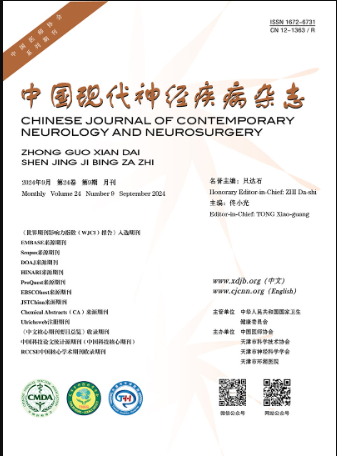Effect of motor imagery therapy on cognitive function of patients with stroke
Q4 Medicine
引用次数: 2
Abstract
Objective To explore the rehabilitation effect of motor imagery therapy on cognitive function of stroke patients. Methods A total of 99 stroke patients with mild to moderate cognitive dysfunction were randomly divided into 3 groups: control group (N = 33), cognitive training group (N = 33) and motor imagery training group (N = 33). All patients received conventional rehabilitation training. Before and after 8-week training, all subjects were assessed with Mini-Mental State Examination (MMSE) and Montreal Cognitive Assessment (MoCA). At the same time, event-related potential (ERP) was examined to detect P300 latency and amplitude. Results ompared with before training, MMSE ( P = 0.000) and MoCA ( P = 0.000) scores were significantly increased, P300 latency was shortened ( P = 0.000) and P300 amplitude was increased ( P = 0.000) in 3 groups after 8 - week training. There were significant differences among 3 groups on MMSE ( P = 0.030) and MoCA ( P = 0.013) scores, P300 latency ( P = 0.004) and P300 amplitude ( P = 0.009) before and after training. Among them, cognitive training group and motor imagery training group had significantly higher MMSE ( P = 0.019, 0.021) and MoCA ( P = 0.003, 0.031) scores, shorter P300 latency ( P = 0.020, 0.003) and higher P300 amplitude ( P = 0.003, 0.002) than control group. Conclusions Motor imagery training can not only improve motor function of stroke patients, but also improve their cognitive function. DOI: 10.3969/j.issn.1672-6731.2017.06.005运动意象疗法对脑卒中患者认知功能的影响
目的探讨运动意象疗法对脑卒中患者认知功能的康复效果。方法将99例脑卒中轻中度认知功能障碍患者随机分为3组:对照组(N = 33)、认知训练组(N = 33)和运动意象训练组(N = 33)。所有患者均接受常规康复训练。8周训练前后,采用简易精神状态测试(MMSE)和蒙特利尔认知评估(MoCA)对所有受试者进行评估。同时,通过事件相关电位(ERP)检测P300潜伏期和振幅。结果与训练前比较,8周训练后3组患者MMSE (P = 0.000)和MoCA (P = 0.000)评分均显著升高,P300潜伏期缩短(P = 0.000), P300振幅升高(P = 0.000)。3组患者训练前后MMSE (P = 0.030)、MoCA (P = 0.013)评分、P300潜伏期(P = 0.004)、P300振幅(P = 0.009)差异均有统计学意义。其中,认知训练组和运动意象训练组的MMSE评分(P = 0.019, 0.021)和MoCA评分(P = 0.003, 0.031)显著高于对照组,P300潜伏期(P = 0.020, 0.003)显著低于对照组,P300振幅(P = 0.003, 0.002)显著高于对照组。结论运动意象训练不仅能改善脑卒中患者的运动功能,还能改善脑卒中患者的认知功能。DOI: 10.3969 / j.issn.1672-6731.2017.06.005
本文章由计算机程序翻译,如有差异,请以英文原文为准。
求助全文
约1分钟内获得全文
求助全文

 求助内容:
求助内容: 应助结果提醒方式:
应助结果提醒方式:


